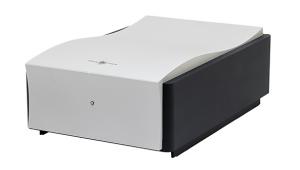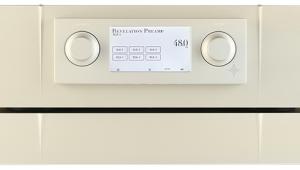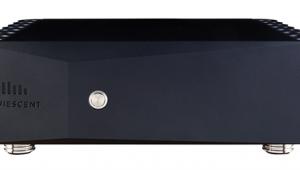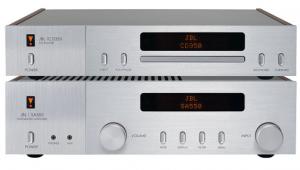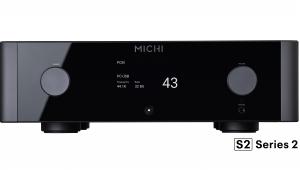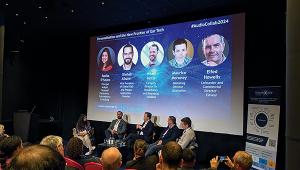Electrocompaniet 'Electro' (Vintage)
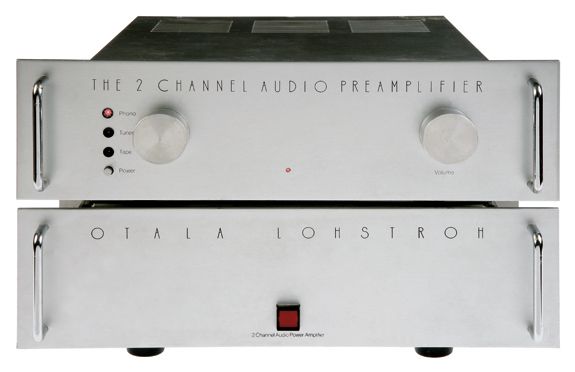
Back in 1966, a Norwegian pop band called Mojo Blues topped the local charts with their first single, a cover of The Stones’ ‘Lady Jane’. They followed up with more hits, but eventually disbanded. By 1972, Mojo Blues’ frontman Per ‘Abe’ Abrahamsen had started Electrocompaniet as a small business, importing cheap Bulgarian speakers and building basic PA electronics.
But the story of the Electrocompaniet hi-fi amplifier begins in February 1973, when Svein Erik Borja, a Norwegian broadcast and record producer who had produced Mojo Blues’ records, attended the 44th Audio Engineering Society Convention in Rotterdam.
One of the papers presented was An Audio Amplifier For Ultimate Quality Requirements by Jan Lohstroh and Matti Otala, both then working (Otala while on a sabbatical from his Finnish university) at the Philips Research Laboratories in Eindhoven.
At that time, not so long after the general switch from valves to transistors, amplifier designers were starting to achieve much lower figures for total harmonic distortion than before, by using a lot of negative feedback. But it was already being suggested that the THD figure did not tell the whole story.
THE FIRST PROTOTYPES
As early as 1970, Dr Matti Otala had introduced the concept of Transient Intermodulation Distortion (TIM) as a new performance indicator, offering an explanation of why the power amplifiers with the lowest THD did not sound the best. So the Lohstroh-Otala AES paper referenced Otala’s earlier work, and described a power amplifier – designed by Lohstroh with input from Otala and built in the Philips labs – claimed to overcome the shortcomings of current commercial designs. The presentation given by Otala included a sound demonstration, and the paper provided a schematic of the complete amplifier. Borja was impressed by the presentation, as it chimed in with his own dissatisfaction with the sound of the transistor amplifiers he’d been using.
He decided he wanted to have this amplifier built for himself. He took the paper back to Norway and enlisted the help of Nils Jorgen Kjaernet, at the Nera radio and telecomms company, to make the circuit boards and also help with the mechanical design. Then he went to see Per Abrahamsen at Electrocompaniet. Two prototype amplifiers were built, and these sounded so good that Borja and Abrahamsen decided to go ahead and build a series of ten units.
Around this time, in the spring of 1975, a keen young electronics student named Terje Sandstrom joined the small company. As he recalls, it was then located in a rundown part of Oslo, in an apartment over a car repair shop. ‘When I came in there I was 18 years old. I’d been playing with electronics since I was very young. I was making tube amplifiers when I was about 14. I had made a small preamplifier, based on some magazine article, and modified it a bit, but I couldn’t make it work properly. I went in there to buy loudspeakers, but I mentioned this preamp to Per and he wanted to take a look at it.
‘He spent a whole day just helping me with that preamplifier. He found the error. And later I started to just hang around there. It was not like a company, it was more like a club: people dropping in all the time, coming with records, talking. All kinds of people! Then I started to work for Per.’
Starting on assembly work, Sandstrom was soon putting his electronics knowledge to use, and becoming deeply involved in the development of the amplifier.
IRONING OUT PROBLEMS
‘We got measurement equipment in the autumn of 1975. Before that it was just rudimentary stuff, using oscilloscopes and tone generators. But now we found that the amplifier, built to the schematics, did not have the same measurements that were given in the AES paper.
‘It didn’t have the bandwidth, it didn’t have the distortion figures. It didn’t have the slew rate! I don’t remember exactly the numbers, but it was about 20 or 30V per microsecond instead of 100V.
‘This was due, of course, to too high a capacitance in the BD139/BD140 pairs in the output stage. The current from the third stage of the amplifier was not able to drive that capacitance… Simple as that! ‘It took us some time to realise this. At first we thought, well, this circuit is made by these great guys, we must have done something wrong! In fact it might have been the differences between the transistors that they got out of the lab at Philips, and the ones we got as production units. I say this because I remember that Matti was so surprised at seeing those results, when there was nothing wrong with the amplifier in itself.’
Lohstroh and Otala did not want Electrocompaniet to use their names because the complete design had not been authorised by them. After a visit to Otala in December 1975, the product was known instead as The 2 Channel Audio Power Amplifier.
US REACTION
On a trip to the USA, Svein Erik Borja took an amplifier with him to show to friends in California. It led to a review in the underground magazine Audio Critic. It opened: ‘Okay, audio freaks, eat your hearts out. Here’s what we think is the world’s best-sounding power amplifier and (a) you can’t buy it here and (b) it’s much too low-powered to be practical.’
Further down, Audio Critic noted: ‘We understand that the circuit has the blessing of Matti Otala, the Finnish arch-enemy of TIM, although it’s incorrect to refer to it as “the Otala amplifier” as some people have, since Otala isn’t in the business of designing circuits for the audio industry.’ On that American trip the amplifier had blown up, which led to the on-the-spot, overnight addition of a short-circuit protection circuit.
When the review came out, Electrocompaniet was deluged with enquiries. Says Sandstrom: ‘After the Audio Critic review, we shipped mainly to the USA in late 1976 and 1977. In fact the UK was rather late in this respect. Most of the people we knew were Americans! John Curl got a very early amplifier. We’d met him in March 1976, when we went to the AES convention in Zurich.
‘The sound of the amplifier was very surprising for people, and the fact that at that time it had only 20dB of feedback made the sound very tube-like. One thing which fooled people a bit was that the harmonic distortion was higher than it was intended to be, due to the problems with the design. And that enhanced the tube-like sound. Later, that distortion was taken down, and it got a much more clear sound.
‘It was originally regarded as a kind of crossover amplifier. It came at the time when designers had found they could design power amplifiers with an enormous amount of feedback, and get very, very good measurement results… but they sounded awful.
‘What I’ve seen after 1980 is that amplifier manufacturers have adopted these ideas and changed their amplifiers in that more moderate direction. So on the one hand, this was an enthusiast amplifier, with a specific sound. On the other hand, it was a wake-up call for the industry.’
Sandstrom stayed with Electrocompaniet until 1979, and continued as a consultant designer for some years more. Manufacturing was moved to Scotland for a time, and the 25W amp gave way to the more powerful Ampliwire models. Today, Sandstrom’s web pages provide the story of the original amp [http://home.online.no/~tsandstr/OtalaStory.htm] and other information.
When Sandstrom looked at the pictures you see here, he told us immediately that this amplifier must be a very early one. The ‘Otala Lohstroh’ front plate would have been made between May and December ’75, while the T-shaped circuit boards, close to the finned heatsinks, were only used in the first 50 units.
One of the board’s two layers was a ground plane, and when mounting components it was all too easy to create short circuits, which would go unnoticed until it was too late. ‘These boards were completely a nightmare! They were not repairable. Also, you can see that every transistor has been screwed individually onto the cooling fin. The screws threaded straight into the cooling fin, and those threads were always being ruined because this was soft aluminium. Just one small extra turn and they were broken. So we got rectangular boards instead, with all the transistors on one side, with clamps which held them down and screws going through the cooling fin with a nut on the other side.’ However, our ‘early’ amplifier has been fitted with a later power supply board, from 1976 or 1977, complete with its protection relay.
STEVE LISTENS
It was really exciting to be able to hook up this vintage combination at home, and it was easy to hear why it had made such an impact 35 years ago.
Back in 1976, most hi-fi listening was done via a phono (disc) input, and an MM one at that. So I started by connecting a basic Rega turntable and Goldring 1020X cartridge. I put on John Lennon’s Imagine [Apple PAS 10004]. From the first rolling piano chords, this was a great, communicative sound, with a good sense of depth between the speakers. But on high-register piano bits of ‘Jealous Guy,’ for example, the sound from the Goldring could be just too thin and scratchy.
I changed to the SME Model 10 with a Roksan Corus Silver, with FG II fine line stylus. Now you could hear more into the production, the double-tracking that gives the piano a full-bodied sound for example, while those treble tinkles were better defined. Bass was now pleasingly free and open.
On Gil Scott Heron’s The Revolution Will Not Be Televised [RCA SF8428] the Electro combination put over the bass lines with melodic ease, while the midrange was communicative but with a hint of coarsening. It was full-bodied, yet could have given a little more clarity to the artist’s diction.
SILVER SOUNDS
With CD, I started with the gorgeous voice of Rosa Passos on Rosa [Telarc CD-83646]. My first blast came with the Electro power amplifier alone, using a respectable tube preamplifier. I felt that the sound was warm and ingratiating, perhaps too warm. Switching to the Electro preamp, I felt suddenly that here was indeed a great combination. It seemed that the neutral, even cool sound of the Electro preamplifier was now balancing the warmth of the power amplifier to just the right degree – overall this was beguiling!
And with Keith Jarrett and Charlie Haden on Jasmine [ECM 2733485], the Electrocompaniet really seemed able to let you into the feeling of calm and unhurried mastery that characterises these performances. Electrocompaniet founder Per Abrahamsen re-formed his Mojo Blues band in 1982, and continued recording and gigging into the 21st century. And our original Electro amp, though old, fragile and ill-equipped for today, has somehow managed to keep on rocking too.
VERDICT
Our vintage power amp sounded strikingly free and open, more inviting than most solid-state amps of its era but with a notable warmth. The preamp complemented it well, even if its phono stage would not compare with good modern designs. It’s ironic that the so-called ‘Otala amplifier’ won deserved acclaim for its sound even while missing the technical goals set by Otala and Lohstroh themselves.
Originally published in the December 2011 issue





